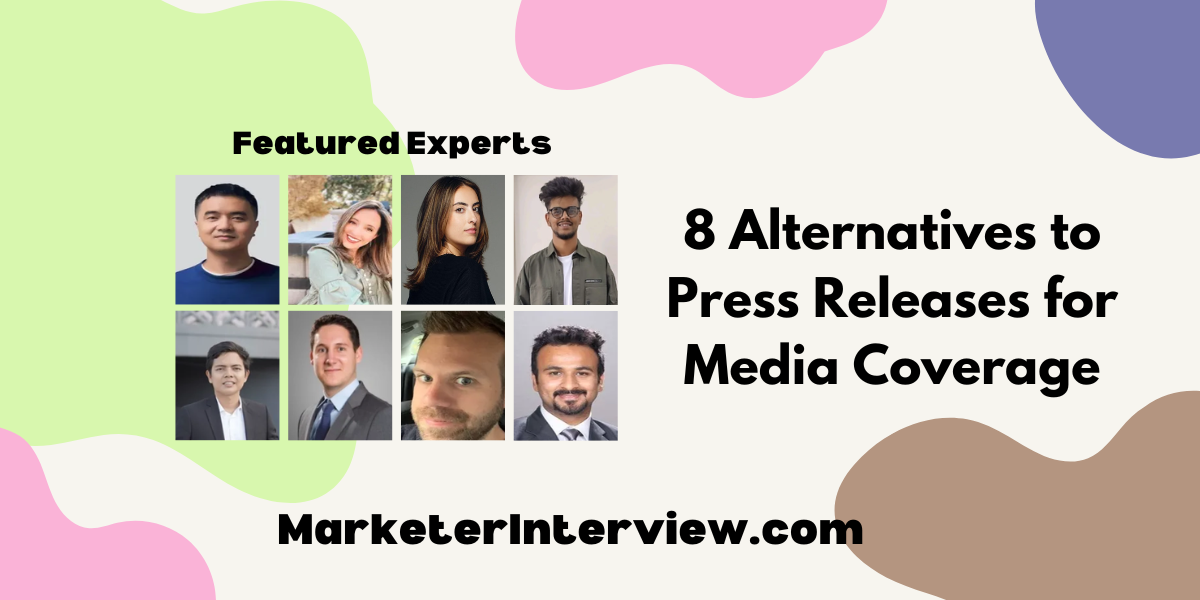8 Alternatives to Press Releases for Media Coverage
In the quest for effective media coverage beyond traditional press releases, we’ve gathered eight innovative strategies from founders, CEOs, and marketing experts. From pitching exclusive stories to journalists to generating original research for coverage, explore the diverse alternatives these professionals recommend for making your brand stand out.
Want to get quoted in MarketerInterview.com content just like this? Apply to become a contributor today!
Contents
Pitch Exclusive Stories to Journalists
One of the most effective alternatives to traditional press releases is pitching exclusive stories directly to journalists or media outlets. By offering a unique angle or exclusive content, you create a sense of urgency and value, which can lead to more in-depth coverage. This approach allows you to tailor your narrative to fit the specific interests of the journalist or outlet, increasing the likelihood of it being chosen. Building relationships with journalists through personalized pitches not only garners immediate attention but also fosters long-term media partnerships.
Ashley Betkouchar, Marketing and PR Specialist
Write Articles for Targeted Publications
Writing articles or columns for publications is a great alternative to press releases. First, create a spreadsheet of publications that relate to your expertise, your brand, or product. You want to make sure the publication shares the same target audience as you (audience leveraging).
Then, reach out to the editors of the publications and pitch them your articles with links to your services or products. Editors are more than happy to accept free content contributions. And it’s free publicity for you. It’s a win/win situation, and a very advantageous approach to media coverage.

Charlene Lazewski, Founder, Charlene and Co. Media
Publish Case Studies and Success Stories
A better alternative to press releases for media coverage is to write and publish case studies and success stories. With case studies, you get to highlight how your business’s service or product works, its features, and how target customers can use them to fulfill their particular needs.
On the other hand, success stories highlight the impact of your product or service on its users. Success stories help paint a picture of what is possible when your target customers adopt your company’s offerings to help them address their needs.
Case studies and success stories are a better alternative to press releases because they give you publicity while at the same time reviewing what your business offers and its impact when put to good use.

Clooney Wang, CEO, TrackingMore
Utilize Outreach Services Like HARO
Outreach services like HARO are a specific alternative to press releases for media coverage. Media coverage proactively contacts journalists, editors, and bloggers for your brand’s coverage and visibility.
For example, we tried a platform called Connectively (previously named HARO), where journalists (from high-domain-authority websites) ask their questions to seek expert advice, quotes, and insights.
We write well-thought-out answers for them, and once those answers are accepted by the journalists, they are published on their websites, earning us high-quality backlinks.

Rahul Vij, Co Founder, WebSpero Solutions
Create Local YouTube Ads
What I’ve found effective is creating and running local YouTube ads. As a handyman, I experimented with this approach to reach a younger, more tech-savvy audience in my area.
I created a series of short, engaging videos showcasing quick home repair tips and tricks. For example, one popular video demonstrated how to fix a squeaky door in under 60 seconds. I then used YouTube’s local targeting options to ensure these ads were seen by people in my service area.
The results were surprising. Not only did these ads drive direct business, but they also caught the attention of a local morning show producer. They saw one of my ads and invited me to do a recurring “Handyman Corner” segment on their show. This led to far more extensive media coverage than a traditional press release likely would have.

John Cammidge, Handyman, Handyman John
Partner with Influencers
Social media platforms have become an integral part of people’s daily lives. As a result, companies and organizations can leverage these platforms to reach a wider audience and gain media coverage.
By utilizing social media channels such as Facebook, Twitter, Instagram, and LinkedIn, businesses can create a buzz around their brand or product without relying solely on traditional press releases. They can engage with their followers by posting informative content and exciting updates about their company. This strategy not only increases brand visibility but also generates organic conversations that can potentially lead to media coverage.
Furthermore, partnering with social media influencers who have a significant following in your target market can also be a highly effective way to promote your brand or product. Influencers have a loyal and engaged audience, and their endorsement can carry significant weight in the eyes of the public. By collaborating with influencers, businesses can reach a wider and more diverse audience, increasing their chances of gaining media coverage.

Danny Colacicco, Founder & CEO, Panda Pro Home Buyers
Collaborate for Podcast Cross-Promotion
Recently, at Gema Sumatra, we cooperated with another local news media institution to create a podcast discussing specific problems and opportunities for micro- and small businesses in our region. This was not only about sharing content but also strategically increasing our coverage of the media.
We first created a purpose for our content.
It was through a coalition with another local, credible media outlet that we could use their audience and give them ours for corresponding insight and expertise. In-depth discussions with local business owners shared stories that most resonate with the community.
The next step is using cross-promotion, which not only exposes our brand to a broader audience but also visibly adds to our credibility as a trusted source for local news and business insights.
Probably the most significant benefit to this campaign was the potential organic media coverage it could attract. It wasn’t some static press release but a really great piece of dynamic content other media found valuable to share.
This created that ripple effect, where discussion points from the podcast began being picked up and referenced in other local news stories, further increasing our reach and presence in the media landscape.

Ar. Azlan Shah, Chief Editor, Gema Sumatra
Generate Original Research for Coverage
Let me tell you, when it comes to snagging media coverage, creating original research or industry reports has been an absolute game-changer for us. It’s like press releases on steroids, but way more valuable and shareable.
Instead of just pumping out standard announcements, we’ve been diving deep into our industry data, running surveys, and compiling trend reports that journalists and bloggers can’t resist. And let me tell you, the impact has been huge!
Not only does it position us as thought leaders in our space, but it also gives media outlets meaty, data-driven content they can sink their teeth into. They’re always hungry for fresh stats and insights to fuel their stories.
Plus, this approach has opened doors to way more diverse coverage—we’re talking about major industry publications, mainstream news sites, and even podcast interviews. It’s been a total breakthrough in terms of reach and credibility.
At the end of the day, it’s about providing genuine value to both the media and their audience. When you bring something truly newsworthy to the table, you don’t have to chase coverage – it comes to you!

Roshan Singh, SEO Executive, Urban Monkey
Want to get quoted in MarketerInterview.com content just like this? Apply to become a contributor today!






